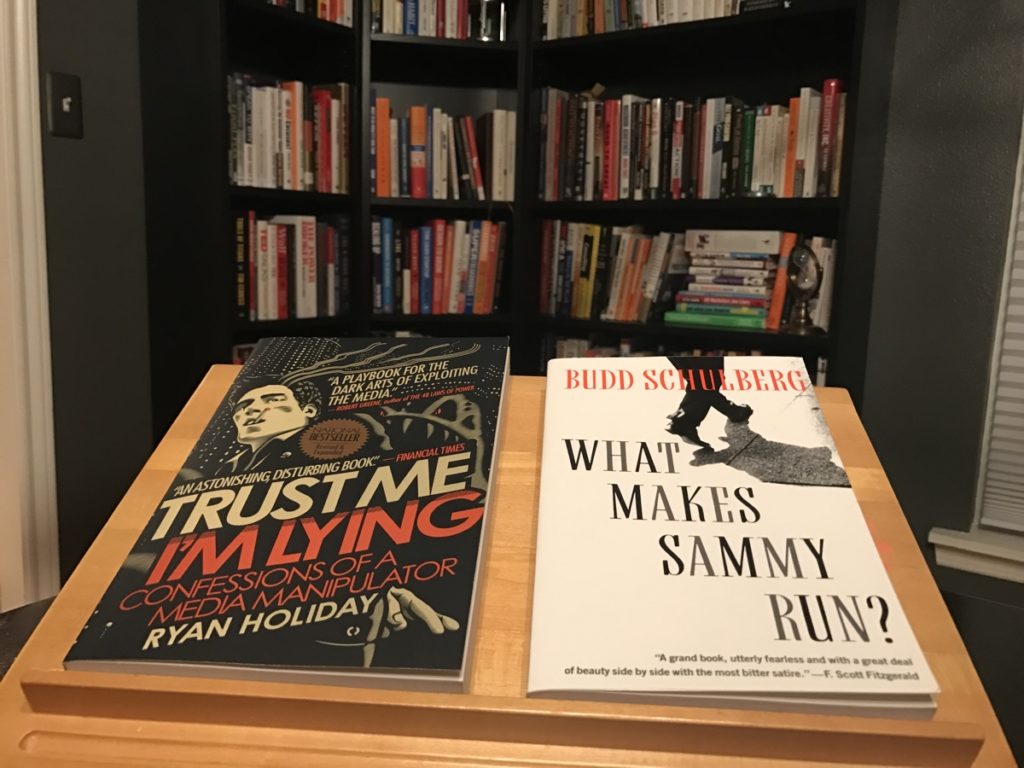What if, in an attempt to create a bomb-proof container, you instead created a device with immense destructive power? Two authors, born over a half-century apart and writing completely different kinds of books, could tell you first-hand.
Sammy Glick is a powerful, loathsome, complicated man. Born in Hollywood from the mind of author Budd Schulberg in his seminal work, What Makes Sammy Run?, Sammy sprang to existence in the 1940s as a cautionary tale of ambition, greed, and hubris run amok. Somewhere along the way, as the 20th century morphed from the united age of WWII to the cynical era of Vietnam, Sammy himself morphed into something of a role model – not only for wannabe Hollywood executives, but also for up-and-coming business executives in a hurry to get to the top. All of this to the horror of Sammy’s creator, Budd Schulberg:
“What has happened in America that has so drastically changed our impression of Sammy Glick from dread repugnance to upwardly mobile acceptance, if not actual admiration and emulation? The book I wrote as an attack on anti-social behavior has become a how-to book on looking out for Number One.”
Despite the evolution in perception of Sammy throughout the years, some still read the novel as a cautionary tale. One such reader, media manipulator turned author Ryan Holiday, cites What Makes Sammy Run? as his favorite work of fiction. He first read it at 19, just before launching a career equally as complicated as Sammy’s Hollywood saga. In the epilogue of Ego Is the Enemy, Holiday explains:
Yet over the next few years, I worked myself into a nearly identical situation as the characters in the book. Not just summoned to the palatial home to watch the expected and unavoidable dissolution of a person I admired. But to find myself dangerously close to my own shortly thereafter.
I know the passage struck me because when I went to type it up for this epilogue, I found in my original copy, pages covered in my own handwriting, written years before, detailing my reaction, right before I had set out into the world. Clearly I had understood Schulberg’s words intellectually, even emotionally – but I had made the wrong choices anyway.
In other words, in an act we are all guilty of, Holiday was told the stove was hot, saw someone burn his hand on it, then touched it anyway.
Toward the end of his career with American Apparel, Holiday tried to put it all in perspective in his memoir/expose Trust Me I’m Lying. The book details how Holiday manipulated the media through a series of carefully crafted deceptions that a headline-hungry media was eager to swallow whole.
Holiday meant for Trust Me I’m Lying to be a cautionary tale as well, exposing the weaknesses and vulnerabilities of the media in the hopes that once exposed to the public, they would no longer exist. And much like Schulberg’s What Makes Sammy Run, but in quicker fashion thanks to our time-compressed society, Holiday’s book has become a how-to manual for others trying to sensationally manipulate the media to serve their own purposes. Most notably, blogger Milo Yiannopolous, who actively courts controversy at any cost. This point has not been lost on Holiday, who wrote about it for the New York Observer recently:
If any of this sounds familiar, it should. Because it’s basically the exact playbook that right wing blogger Milo Yiannopoulos is running on his own cross-country trolling tour. By almost any metric but political correctness, it’s been masterfully successful—his book has since been to #1 on Amazon twice, and the protests at UC Berkeley last week generated national headlines and were addressed directly by the President.
The déjà vu is not accidental. Numerous leaders of the alt-right movement read the book I published in 2012, which outlined exactly how this media strategy works. Several have told me Trust Me, I’m Lying is their bible.
It’s a sad irony for me, since I wrote the book as an explicit warning about how broken our media system was and why it needed to be fixed. As I would say in interviews, the strategies that I used were designed to market books and clothes for companies like American Apparel, but I was exposing how they worked because I worried how others might soon use them to sell something more nefarious.
In the excerpt above from Ego Is the Enemy, written during 2015, Holiday states he felt he had come full circle with What Makes Sammy Run?, connecting with the plight of both Sammy and the narrator, Al Manheim. A few years removed from that epilogue and he has cut an even tighter arc, circling back around one more time. But it seems to me that this time it’s Schulberg himself that Holiday is really sympathizing with, perhaps more poignantly though. For Schulberg at least, the story was fictional, based on true events he observed, but largely created. Characters he manipulated to deliver the story. For Holiday, it’s more personal. The subject matter is his early life’s story, his own work. The manipulation is real and follows the thread he first pulled on.
Was it inevitable? Maybe. Probably, in fact. Sometimes we can try so hard to NOT be something that we end up becoming that very thing in spite of ourselves. We think we’ve been looking through a window for 10 years and wake up one day to realize it’s actually a mirror.
Both Schulberg and Holiday attempted to warn us to not be seduced by the cheap and tawdry, the lure of the sensational over substance. In the end, they were both victims of being too good at their craft. Intending to paint a horrifying portrait, instead they created art that many beholders could only see as beautiful.




0 Comments